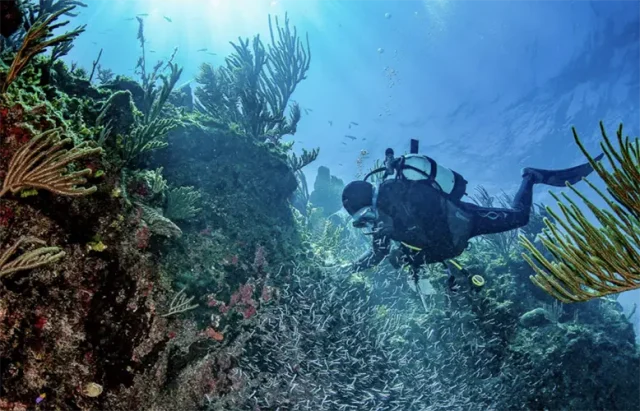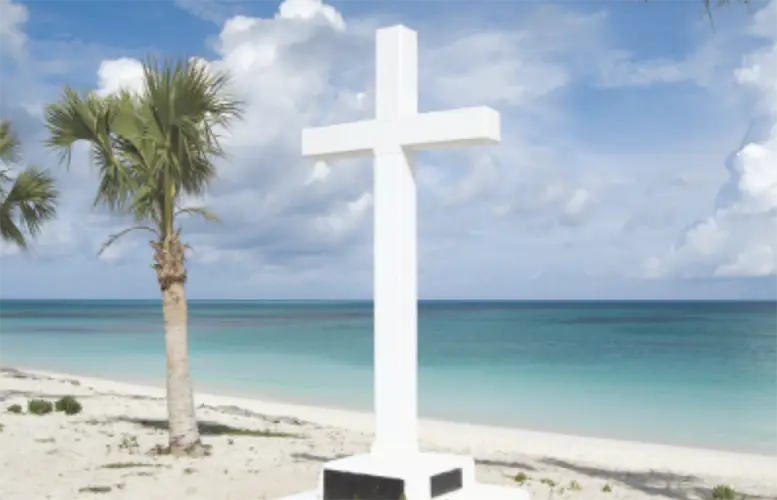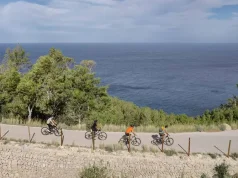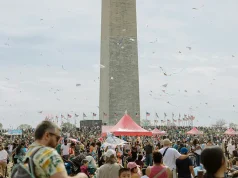
The unique Bahamian island of San Salvador sits in the Atlantic to the east of the 700-island archipelago. It’s not to be confused with Little San Salvador, which is located halfway to Nassau. Geographically unusual, San Salvador is a rocky plateau that is the very topmost part of a 15,000-foot mountain which rises from the ocean floor. The rolling hills which stand above the water have created a spectacular lagoon linking the major settlements on the island. An inland blue hole, connected to the ocean by an undiscovered channel, is filled with seawater, not fresh as one would expect. The Great Lake is surrounded by a park which protects the lagoon and surrounding mangrove ecosystems, both critical to the preservation of several endangered species of reptiles and birds.
Since 2015, the entire island has been designated a marine preserve. Coral farms have been established to assist in assuring the reefs survive the effects of global warming. Spectacular sandy beaches welcome tourists, but it is the underwater attractions that bring the divers to these shores for a diving experience unlike any other.
Going Deeper in San Salvador
Nearly 50 dive sites ensure that there’s seldom any competition from other divers to observe the many species of underwater creatures that call these waters home. The island overlooks an extensive coral plateau, with several patch reefs surrounded by a sandy bottom. These reefs are home to hundreds of species of fish and invertebrates. The reef falls away with a vertical wall that descends up to 115 feet (35 metres). This is followed by a steep slope after 328 feet (100 metres), beyond the reach of scuba divers, but home to magnificent pelagic fish, such as hammerhead sharks, bull sharks, Caribbean reef sharks, silky sharks, oceanic whitetip sharks and occasional tiger sharks. Caves, chimneys, natural faults and tunnels, which shelter smaller flora and fauna, add to the exceptional variety of seascape on every dive. Seahorses cling to the plants, sea stars and queen conches prowl the sandy bottoms, and hordes of tropical fish dart amongst the colorful corals. Green, hawksbill and leatherback turtles graze on the vegetation while eagle rays prowl the walls. Dolphins investigate both divers and their boats.
In shallower waters, drift dives are popular, sheltered from the wind and waves on the leeward side of the island.
This action is influenced by the Antilles Current, which merges with the Gulf Stream as it moves northwards. The current cools the island waters in summer and warms them in winter, keeping the water temperature relatively mild and consistent throughout the year.

Diving in Good Company
Only Blue Diving Bahamas is the snorkelling and diving center at the Club Med Columbus Isle Resort. Their boats are ecologically advanced, with thermal engines, and one catamaran equipped and powered by solar derived batteries, to minimize water and noise pollution. Their dozen diving instructors and three boat captains speak a mixture of English, Spanish and French. They also provide opportunities for local youth with a wide-ranging training program. Special equipment permits experienced divers to safely descend to an unusual depth of 200 feet (60 metres).
Diving into History
San Salvador is also famous for its history. A stone cross on Long Bay marks the spot where Christopher Columbus made his first landfall in October 1492. He thought he’d reached East Asia, naming the local indigenous people Indians, an error that was to haunt the ages. Offshore, an underwater monument designates where his ships, La Pinta, La Niña and the Santa María, dropped anchor. Originally named Watling Island after a pirate captain, the island’s name was changed in 1926 to reflect Columbus’ landing, which was originally thought to have taken place elsewhere. Over the centuries, various agricultural settlements have been attempted, without much success, until the arrival of tourism, now the island’s principal activity.

The capital and commercial centre of the island, and where the airport is located, is Cockburn Town, named after a former governor of The Bahamas. Several buildings in the town date from the 1800s, including the old jail. A favourite gathering place is the huge almond tree at the entrance of the town. A 160 feet (49 metre) tall lighthouse is located south of the Dixon Hill settlement, built in 1887 by the Imperial Lighthouse Service. There are several other monuments, ruins and shipwrecks to explore on the island.
San Salvador Airport (ZSA) welcomes daily flights from Nassau (NAS), 118 miles (189 km) away, with weekly charters from Fort Lauderdale (FLL) and occasional charters from Montreal and Paris. For more information on this incredible island, visit https://www.bahamas.com/islands/san-salvador.





